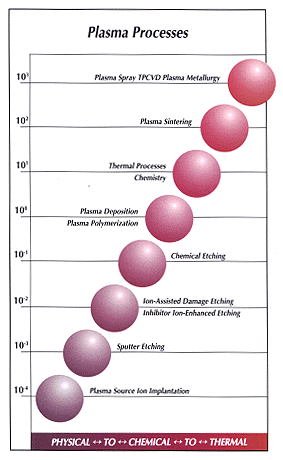|Home|Research|Industry|Education|Contacts|

|
Using PlasmasWhen plasmas are utilized in manufacturing, the application and character of the process involved are governed by the operating pressure of the system. The research areas of the ERC span a progressive range of operating pressures from 10-4 torr to greater than atmospheric pressure. The figure at right displays the types of processes used in manufacturing as a function of the operating pressure of the reactor. At low pressures, physical rather than chemical effects dominate. Such is the case in Plasma Modification of Materials. As the pressure increases, chemical effects become more significant, as in the area of Plasma Etching and Microwave Processing for Microelectronics. At higher pressures, as in Plasma Deposition and Polymerization, deposition effects begin to prevail. At the highest pressure range, used in Thermal Plasma Spraying, the plasma tends to be utilized primarily as a heat (thermal) source. The Engineering Research Center has effectively incorporated into its research a complete range of pressures used in plasma-aided manufacturing. Across the various projects and research groups, many of the same technical questions can arise. For example, each group needs to know the gas and surface temperatures as well as the densities of the various species making up the plasma. To help address some of these common issues and to provide an interconnection across the research areas, the ERC has established four support groups in diagnostics, theory and modeling, engineering statistics, and real time control. |
|Home|Research|Industry|Education|Contacts|
 |
Last Modified: Friday,
August 22, 1997 02:35 PM This page is best viewed by browsers that support background colors in tables. All photographs © 1997 Engineering Research Center for Plasma-Aided Manufacturing. Address comments to ercpam@silver.neep.wisc.edu |